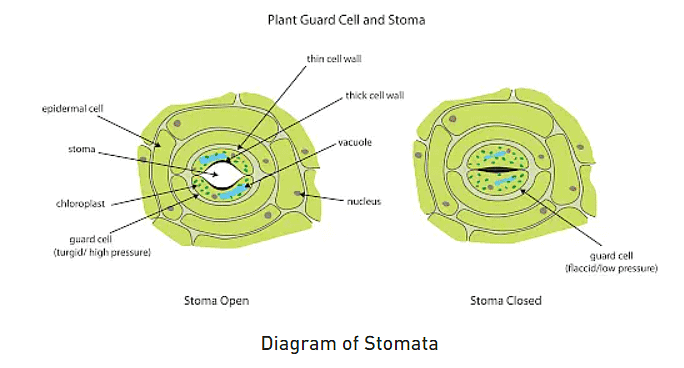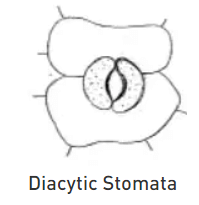Stomata and their types | Botany Optional for UPSC PDF Download
Stomata are tiny openings found on the surface of green plants, serving as crucial sites for the exchange of water and carbon dioxide between the plant and its surroundings. They are easily observable under a microscope and are scattered across the epidermal layer of leaves, stems, and various plant organs. A single opening is referred to as a stoma, and a multitude of stomata are typically present on the leaf surface. Stomata play a vital role in essential plant processes such as transpiration and photosynthesis, which are critical for the plant's survival. These processes are orchestrated by well-defined structures and mechanisms.
Definition of Stomata
Stomata are minute pores or openings in the epidermis layer of the leaves, young stems, and some other parts of green plants which form an important constituent of their functioning.
- Stomatal pores help in gaseous exchanges between the plant and the atmosphere and maintain a healthy rate of transpiration in plants.
- The major functions of the stomata are carried through the mechanism of its opening and closing.
- The chloroplasts present in the stomatal pores contain chlorophyll which along with sunlight facilitate the process of photosynthesis.

Structure of Stomata
The stomatal structure consists of an epidermal cell that is shaped like a kidney and features a central opening known as a pore. Surrounding the stomatal pore are a pair of specialized parenchyma cells referred to as guard cells. These guard cells have the crucial role of regulating the pore's size, thereby preventing excessive water loss from the plant. While there may be slight variations in the shape of these cells, the fundamental mechanism and composition of a stomatal pore remain consistent.
A stoma pore is composed of four essential components:
- Pore
- Guard cells
- Subsidiary cells
- Epidermal cell

Key Features of Structure of Stomata
Epidermal Cells
- These are plant cells that offer physical and mechanical support to the plant.
- Epidermal cells have an irregular shape and constitute the outermost layer of plant tissues.
- They serve as the foundational building blocks of a plant.
- Due to their rigidity, they play a crucial role in enabling the closure of stomatal pores when necessary.
Subsidiary Cells
- Subsidiary cells are distributed throughout various parts of the plant, with a notable presence around stomata.
- In contrast to epidermal cells, subsidiary cells are soft in texture.
- They facilitate the expansion of guard cells and the opening of the stomatal pore.
- Subsidiary cells essentially create a functional space that allows the stomata to operate efficiently.
- Without the presence of subsidiary cells, the pores would not be able to function effectively over an extended period.

Stoma Pore
- The pore serves as the primary opening responsible for all gaseous exchanges, vapor exchanges, and absorption from the atmosphere.
- Without the presence of pores, the entire functioning of stomata would be rendered entirely ineffective.
Guard Cells
- Guard cells are the central and most critical component of a stoma.
- They are characterized by their kidney-shaped appearance and possess a thick inner cell wall.
- Given that the opening and closing of stomata are central to their functioning, and guard cells are solely responsible for this regulation, they hold utmost importance in overall plant maintenance.
Differences between Mitochondria and Plastids
- Function:
- Mitochondria: Mitochondria are primarily involved in energy production through cellular respiration. They generate ATP, the cell's energy currency.
- Plastids: Plastids have various functions depending on their type. Chloroplasts, a type of plastid, are responsible for photosynthesis, while other plastids may be involved in the synthesis and storage of pigments, starch, and lipids.
- Energy Production:
- Mitochondria: They are the powerhouses of the cell, producing ATP by breaking down glucose and other organic molecules.
- Plastids: Plastids do not produce ATP but are involved in the conversion of light energy into chemical energy in the case of chloroplasts during photosynthesis.
- Membrane Structure:
- Mitochondria: Mitochondria have two membranes, an inner and an outer membrane, which enclose the matrix and the cristae (inner folds).
- Plastids: Plastids have a double membrane as well but have a distinct internal structure based on their type (e.g., chloroplasts have thylakoids).
- Color:
- Mitochondria: They do not have a specific color and are not pigmented.
- Plastids: Chloroplasts, a type of plastid, are green due to the presence of chlorophyll, which is essential for photosynthesis. Other plastids may have different colors depending on their pigments.
- Origin:
- Mitochondria: They are believed to have originated from ancient prokaryotic cells through endosymbiosis.
- Plastids: Plastids, including chloroplasts, are also thought to have evolved through endosymbiosis, specifically from cyanobacteria.
- Location:
- Mitochondria: Mitochondria are found in the cytoplasm of eukaryotic cells and are abundant in cells with high energy demands, such as muscle cells.
- Plastids: Plastids are typically found in plant cells and some protists. Chloroplasts are specifically found in plant cells where photosynthesis occurs.
- Products:
- Mitochondria: The main product of mitochondrial activity is ATP, along with some metabolic intermediates.
- Plastids: Plastids can produce various products depending on their type, including glucose (during photosynthesis), pigments, starch, and lipids.
Types of Stomata
The Stomata can be broadly classified into 5 types based on the subsidiary cells, their number and arrangement as follows:
Anomocytic Stomata
In anomocytic stomata, subsidiary cells are irregularly shaped and often challenging to distinguish. They are also referred to as ranunculaceous cells or irregular-celled-type stomata.

Anisocytic Stomata
Anisocytic stomata have three subsidiary cells of unequal size, where one cell is smaller than the other two. The arrangement of these subsidiary cells is not specific, but their number is fixed. They are also known as unequal-celled type or cruciferous stomata.

Paracytic Stomata
Paracytic stomata feature two distinct subsidiary cells, one positioned on the outer side of each guard cell. While there may be more than one subsidiary cell on either side, the arrangement remains parallel to the guard cells. This parallel arrangement allows for significant expansion and contraction of the guard cells. They are also known as parallel-celled type or rubiaceous stomata.
Diacytic Stomata
Diacytic stomata also have two subsidiary cells, but their positioning differs from paracytic stomata. In diacytic stomata, the subsidiary cells are perpendicular to the guard cells, forming a right angle with them. They are also referred to as caryophyllaceous or cross-walled stomata.
Gramineous Stomata
Gramineous stomata consist of two dumbbell-shaped guard cells and two corresponding subsidiary cells. The guard cells are typically narrower in the middle and wider at the ends. The cell walls of the guard cells are thicker in the middle and thinner at the ends. Subsidiary cells are located adjacent to each guard cell and run parallel to them.
Functions of Stomata
- Gas Exchange Facilitation: One of the primary roles of stomata is to enable the exchange of gases. They facilitate the absorption of carbon dioxide (CO2), which plants subsequently break down into carbon and oxygen. Carbon is essential for the plant's growth, while oxygen combines with hydrogen to form the water needed by the plant.
- Regulation of Transpiration: Stomatal pores play a crucial role in controlling the rate of transpiration. They allow for the evaporation of excess water within the plant, which helps maintain an optimal water balance.

- Maintenance of Adequate Water Levels: Stomata have the ability to close during the night, reducing the loss of water through evaporation. This nighttime closure helps prevent plants from drying out and contributes to maintaining a healthy water balance.
- Support for Photosynthesis: Stomata facilitate the exchange of gases and the evaporation of water, both of which are essential for the process of photosynthesis. During photosynthesis, plants use sunlight to convert carbon dioxide and water into glucose and oxygen, ultimately producing food for the plant.
Opening and Closing of Stomata
The mechanism of stomatal opening and closure depends on the turgor pressure, which is caused by the osmotic flow of water in the guard cells. The guard cells expand, when they are turgid, resulting in the opening of stomata. And they become flaccid leading to stomatal closure when the guard cells lose water. Generally, when the light strikes the leaf stomata open and close during the night.
Things to Remember
- Stomata are tiny openings found in the epidermal layer of leaves, stems, and other green plant parts.
- Stomatal pores contain chloroplasts that house chlorophyll and stored energy.
- Stomata play a critical role in facilitating photosynthesis and transpiration in plants.
- The essential components of stomata include pores, guard cells, the epidermal layer, and subsidiary cells.
- Stomata can be categorized into five types based on the characteristics of subsidiary cells: Anomocytic Stomata, Anisocytic Stomata, Paracytic Stomata, Diacytic Stomata, and Gramineous Stomata.
- Vital functions of stomata include promoting the exchange of gases and maintaining an appropriate water balance within the plant.
- The opening and closing of stomata are regulated by the turgor pressure generated by the guard cells.
|
179 videos|140 docs
|
FAQs on Stomata and their types - Botany Optional for UPSC
| 1. What is the function of stomata in plants? |  |
| 2. What are the key features of the structure of stomata? |  |
| 3. How are mitochondria different from plastids? |  |
| 4. What are the types of stomata? |  |
| 5. What are the functions of stomata? |  |

|
Explore Courses for UPSC exam
|

|

















